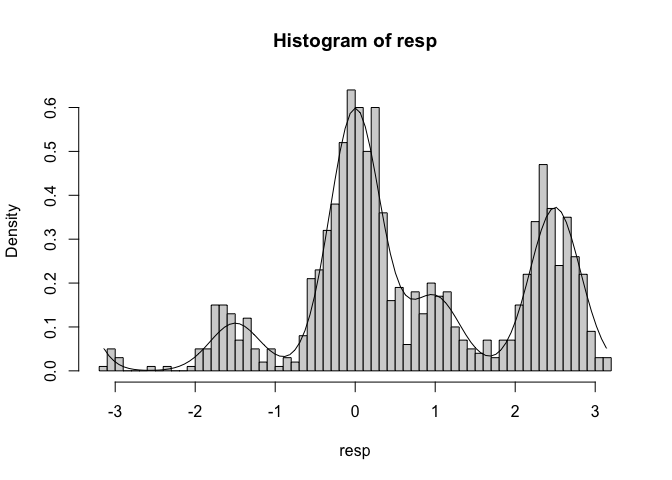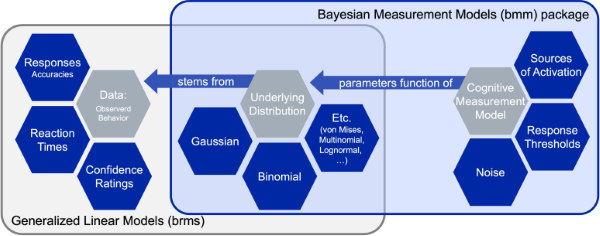
The goal of the bmm (Bayesian Measurement Models)
package is to make it easier to estimate common cognitive measurement
models for behavioral research. It achieves this by combining the
flexibility of the brms (Bayesian Regression Models using
Stan) package for specifying linear model syntax with custom functions
that translate cognitive measurement model into distributional families
that can be estimated using Bayesian hierarchical estimation.
Cognitive measurement models provide a more refined representation of the cognitive processes underlying observed behavior, because they decompose observed behavior into several theoretically meaningful parameters that each represent distinct cognitive processes. Therefore, researchers can use these models to test specific hypotheses about the cognitive processes underlying behavioral data.
In the following sections you find more information on the
bmm package:
You can install the latest version of the bmm package
from CRAN:
install.packages("bmm")Because bmm is based on brms and
stan it requires a working C++ compiler. If you have not
used brms before, you will need to first install the
dependencies. If you are already using brms, you can skip
this step.
Alternatively, you can install the development version of the package or a specific version of the package from GitHub:
if (!requireNamespace("remotes")) {
install.packages("remotes")
}
remotes::install_github("venpopov/bmm")The package was significantly updated on Feb 03, 2024. If you are following older versions (earlier than Version 6) of the Tutorial preprint, you need to install the 0.0.1 version of the bmm package with:
if (!requireNamespace("remotes")) {
install.packages("remotes")
}
remotes::install_github("venpopov/bmm@v0.0.1")Currently the bmm package implements mainly models used
in the domain of working memory research, such as:
Visual working memory
Working Memory (categorical), Categorical Decision Making
However, the bmm package is setup to provide the
foundation for the implementation of a broad range of cognitive
measurement models. In fact, we are already working on implementing
additional models, such as:
If you have suggestions for models that should be added to the package or additional functionality that would improve the usability of the pacakge, feel free to create an issue. Ideally this should describe the model, point towards literature that gives details on the model, and if possible link to code that has already implemented the model.
Given the dynamic nature the bmm package is currently
in, you can always view the latest list of supported models by
running:
bmm::supported_models()
#> The following models are supported:
#>
#> - imm(resp_error, nt_features, nt_distances, set_size, regex, version)
#> - m3(resp_cats, num_options, choice_rule, version)
#> - mixture2p(resp_error)
#> - mixture3p(resp_error, nt_features, set_size, regex)
#> - sdm(resp_error, version)
#>
#> Type ?modelname to get information about a specific model, e.g. ?immbmmThe core function of the bmm package is the
bmm() function. This function takes:
You can get more detailed information on the models implemented in
bmm by invoking the documentation of each model typing
?bmmodel into your console. For example, calling the
information on Interference Measurement Model imm would
look like this:
?immA complete call to fit a model using bmm could look like
this. For this example, we are using the oberauer_lin_2017
data that is provided with the package and we will show how to fit the
Interference Measurement Model to this data. If you want a detailed
description of this model and and in depth explanation of the parameters
estimated in the model, please have a look at the IMM
article.
library(bmm)
formula <- bmmformula(c ~ 0 + set_size,
a ~ 0 + set_size,
s ~ 0 + set_size,
kappa ~ 0 + set_size)
model <- imm(resp_error = "dev_rad",
nt_features = paste0("col_nt", 1:7),
nt_distances = paste0("dist_nt",1:7),
set_size = "set_size")
fit <- bmm(formula = formula, data = data, model = model)Using this call, the fit object will save all the
information about the fitted model. As bmm calls
brms to fit the models, these objects can be handled the
same way a normal brmsfit object is handled:
# print summary
summary(fit)
# plot posterior predicitive plot
brms::pp_check(fit)You can have a look at examples for how to fit all currently implemented models by reading the vignettes for each model here for the released version of the package or here for the development version.
To aid users in improving their intuition about what different models
predict for observed data given a certain parameter set, the
bmm package also includes density and random generation
function for all implemented models.
These function provide an easy way to see what a model predicts for
data given a certain set of parameters. For example you can easily plot
the probability density function of the data for the Interference
Measurement model using the dimm function. In similar
fashion the random generation function included for each model,
generates random data based on a set of data generating parameters. For
the IMM, you can use rimm to generate data given a set of
parameters. Here is an example of how to use these functions. We are
ploting a histogram of randomly generated data from the IMM with a
setsize of four, and overlaying the probability density function of the
model:
library(bmm)
library(ggplot2)
resp <- rimm(
n = 1000,
mu = c(0, -1.5, 2.5, 1),
dist = c(0, 2, 0.3, 1),
c = 1.5, a = 0.3, b = 0, s = 2, kappa = 10
)
hist(resp, freq = FALSE, breaks = 60)
curve(
dimm(x,
mu = c(0, -1.5, 2.5, 1),
dist = c(0, 2, 0.3, 1),
c = 1.5, a = 0.3, b = 0, s = 2, kappa = 10
),
from = -pi, to = pi, add = TRUE
)
bmm packageThe main building block of the bmm package is that
cognitive measurement models can often be specified as distributional
models for which the distributional parameters of the generalized linear
mixed model are a function of cognitive measurement model parameters.
These functions that translate the cognitive measurement model
parameters into distributional parameters is what we implement in the
bmm package.

As these function can become complicated and their implementation
changes with differences in experimental designs, the bmm
package provides general translation functions that ease the use of the
cognitive measurement models for end users. This way researchers that
face challenges in writing their own STAN code to implement such models
themselves can still use these models in almost any experimental
design.
Under the hood, the main bmm() function will then call
the appropriate functions for the specified model and will perform
several steps:
bmm() function:
brms and passing the specified argumentsThis process is illustrated in the Figure below:

bmm packageShould be interested in contributing a model to the bmm
package, you should first look into the Developer
Notes as well as the Contributor
Guidelines. These give a more in depth description of the package
architecture, the steps necessary to add your own model to the package,
and how contributions will be acknowledged.